CRF300L Index page
300L Tubeless Wheels 1
Tubeless Wheel Conversion index page
2 second version: I bought some tyres.
I’ll have spent a staggering £550 each on three handbuilt ‘MT’ wheels for my 300L, all so I can seal the rims and fit tubeless tyres for easy repairs and greater longevity. Oh well, it’s good to support the economy.
When it comes to tyres, people love to fit fatter but I aim to get the closest-to-stock size tubeless tyres that’ll fit the new rims. But as mentioned previously, the smallest available tubeless-ready, ‘MT’ rims are a size or two wider than stock 300L wheels which may mean wider / heavier tyres too. FYI my MT-type tubeless ready wheels will be:
Excel 17 x 2.50
SM Pro 21 x 2.15 (£50 cheaper than Excel equivalent)
Excel 19 x 2.50
Unsprung durch Technik
With wheels (not least pushbikes), unsprung weight (parts not supported by suspension, mostly wheels) exponentially affects acceleration/braking as well as suspension response and probably mpg and appetite. You know how I feel about mpg. Imo, efforts to limit rotating mass are worthwhile on a 150-kilo bike with only 28 horsepower. As I wrote while preparing the Him “… it’s why your Hoka trainers weigh only 320g [i.e: as little mass/inertia as possible to do the job]”. Adv riders go on about swapping pipes and ‘bars and batteries to save weight (while having to add it elsewhere), but tyre weight is rarely considered and can vary quite a lot.
My wider rims may weigh more, so might the slightly over-sized tubeless tyres. Overall, my tubeless conversion may barely save weight.
‘What tyres do you recommend?’
In line with EU diversity initiatives, I try and never use the same tyre twice. It’s good for the book, too. But when a mate donated a new Michelin Anakee Wild 120/70 R19, I thought I may as well go all-Wild, as I did with no regrets on the heavy Himalayan a few years back (left).
I was risking EU sanctions until I was reminded of my own words: a rear Anakee Wild to match the 19 comes no smaller than 130/80-17 but weighs a staggering 7.5kg – enough to give my poor Honda a hernia.
I don’t know if being a radial adds weight – apparently not according to this albeit contradictory article I found on the internet. And then I clocked my fat-tyre mate’s front 19er at a hefty 5.2kg – more suited to a CB500 than my simpering trail puppy. Barman, double hernias all round!
Back to the drawing board. Along with Kenda K784 Big Blocks, Bridgestone’s AX41 Adventure Cross (left) is a do-it-all 50/50 jobby I’ve been wanting to try. The advent of the AX41 a few years ago culled Bridgestone’s range of Trail Wings, some of which I’d have happily chosen for the 300L. What’s left in TWs are tube type and pitched as ‘retro’ (pre-Adv era) tyres.
Best of all, unlike Mich, Bridgestone do an AX in 120/80 17 TL (118mm wide – 1mm more than the stock IRC) as well as a nicely slim, 92mm-wide 90/100 19, plus a regular 90/90 21 at 85mm wide. These widths are all verified; you’ll find broadly similar AX41 width data listed here, but tyre weights are something you rarely find listed publicly, even in pdf online catalogues. I had to email Bridgestone Technik in the Netherlands who, to my surprise, promptly responded down to 3 decimal points:
- BATTLAX ADVENTURE CROSS AX41 – claimed actual
- Front 90/90-21 M/C 54Q TL – 4.428kg 4.6kg / 85mm wide. Inflated ø 696mm
- Front 90/100-19 55P TL – 4.375kg 4.4kg / 92mm mm wide. Inflated ø 658mm
- Rear 120/90-17 M/C 64P TL – 5.516kg / 6kg / 118mm wide
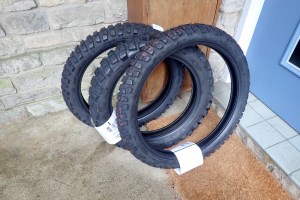
Nice numbers but as usual, manufacturers’ weighing devices seem to be calibrated sunny side up. Using the same scales, the rear 120 AX41 comes in at 6kg, still 1.5 kilos or 20% lighter than a 130 Mich Wild. My current rear IRC also weighs 6kg with tube – and such OEM set ups are often the lightest possible to eek out good performance figures from reviewers to whom longevity is not an issue. More numbers you say? The little used Mitas 4.00 18 trials tyre my 300 came shod with weighed 6.9kg with tube. And out of interest, I’m told the old favourite Conti TKC which I last used on a 660Z Tenere 15 years ago, weighs 4.1kg for a 90/90-21 TL and 5.4kg for a 120/90-17, but I recall they are quite soft or flexible tyres whiuch is why people love them on the dirt. As mentioned earlier, these tyres and tube combos work out heavier than the back wheel, at 5.4kg with a 40T sprocket and rim lock.

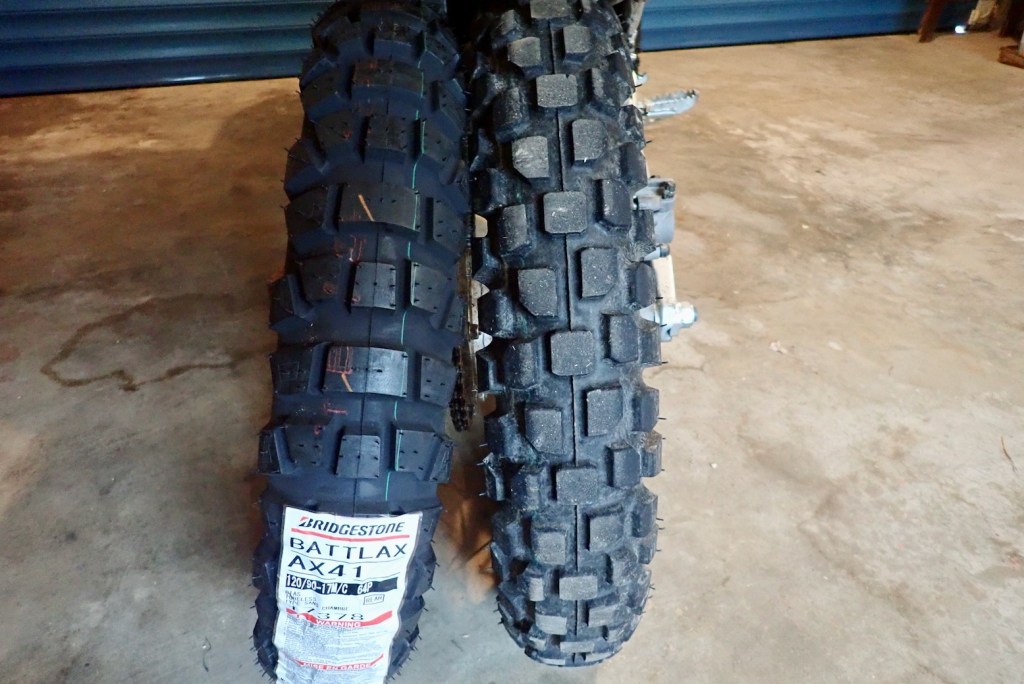
Meanwhile, the fatter 21-inch AX41 front weighs a true 4.6kg, 170g heavier than claimed and 200g more than current IRC with tube at around 4.4kg. The 19er is just what I was hoping for, it’s slim at 92mm and feels light, also at pretty much what Bridgestone say: 4.4kg. Height wise, unmounted the 21’s diameter is 27.4″ (696mm) vs 25.9″ (658mm) on the 19, at 38mm a bit less than the 2 inch/51mm variation you’d expect. And it only cost £83! Interestingly, all three tyres are Made in Japan. Not even Honda can manage that with a whole 300L!
| Honda 21 wheel | SM Pro 21 TL | EXCEL 19 TL | Honda 18 rear | EXCEL 17 TL |
| 3.9 kg | 4.6 kg | 4.4 kg | 5.4 kg | 5.6 kg |
| IRC 80/100 21 + tube | AX41 TL 90/90 21 | AX41 TL 90/100 19 | IRC 120/80 18 + tube | AX41 TL 120/90 R17 |
| 4.4 kg | 4.6 kg | 4.4 kg | 6 kg | 5.5 kg |
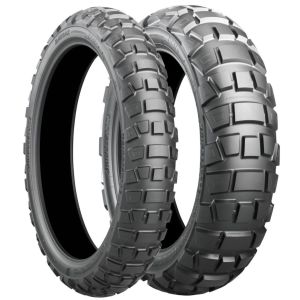
It’s eye opening that a set of wheels on a dinky, 150-kilo bike can weigh over 20kg, but they’re right at the coal face, dealing with all sorts of forces and impacts.
I think that on anything from 500cc and 45hp upwards, all this gram counting is unnecessary, but unsprung weight on a 300L matters. Will the seat of my pants notice the difference between a 7.5 kilo Wild and the 6-kilo AX41? Probably not without bluetooth telemetry, but I’d sooner take the lighter AX which still feels pretty rugged for a ‘250’ trailie.

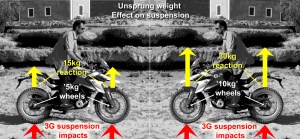
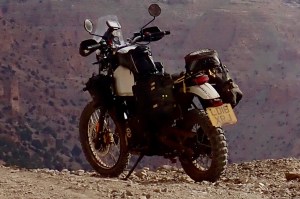

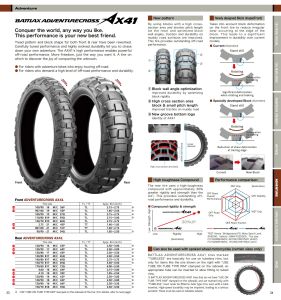
Great observations Chris thanks!!!
LikeLiked by 2 people